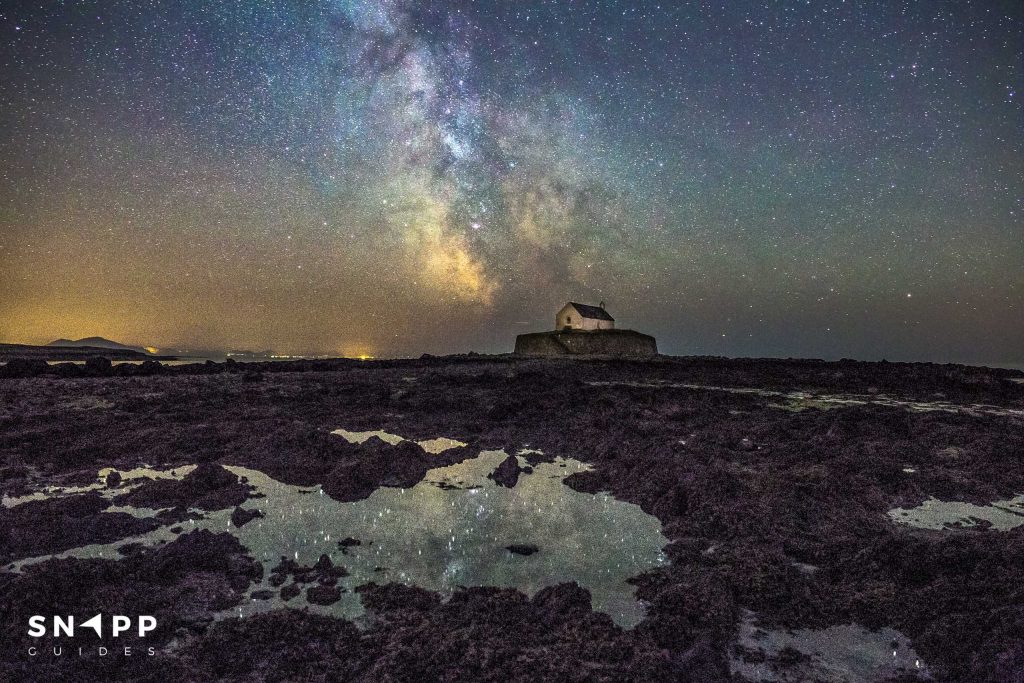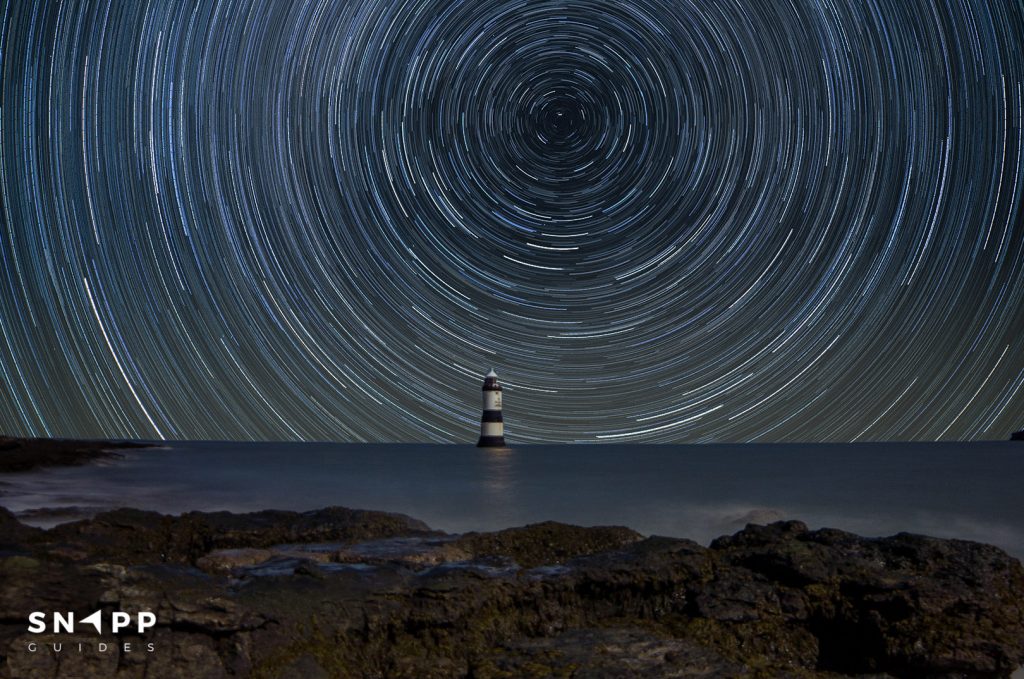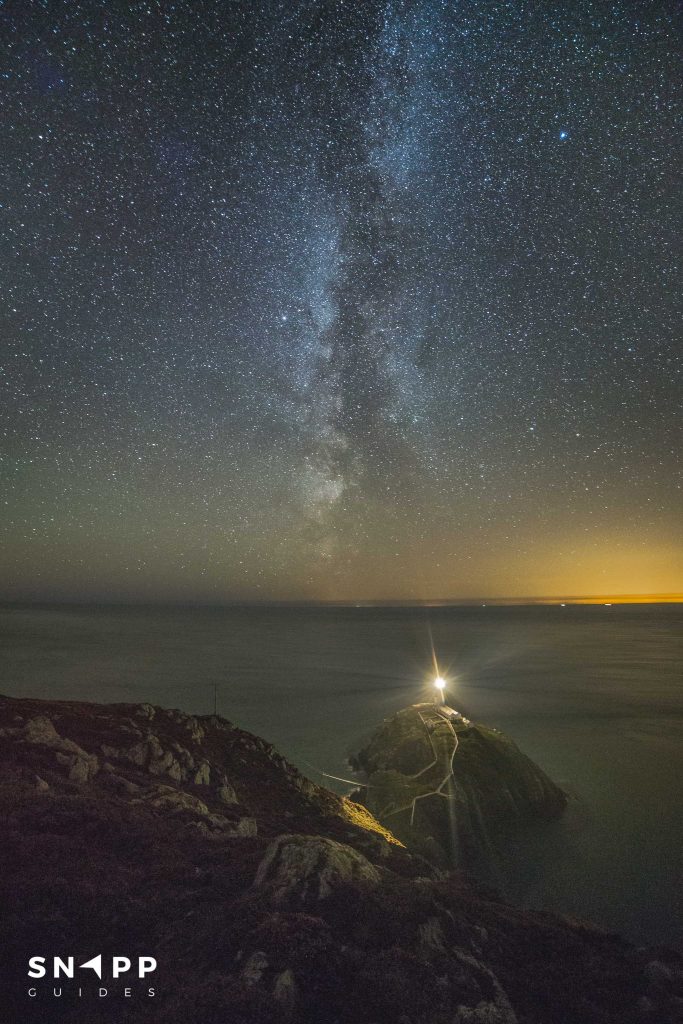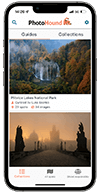Three top locations on Anglesey for night photography
The Isle of Anglesey in North Wales is a stargazers’ paradise. The night sky is much darker here than in many other places across the UK, providing a wealth of great dark locations for night photography. Here are three top locations on Anglesey for night photography by SNAPP Pro photographer, Elgan Jones. St. Cwyfan Church
Popularly known as the Church in the Sea (or eglwys bach y mor in Welsh), St Cwyfan Church is perched on a tiny island called Cribinau and encircled by a sea wall. This simple medieval church dates back to the 12th century and hosts some of the darkest skies on the island. Be sure to visit at low tide to make the most of the unique characteristics of the church surrounded by interesting rock pools and sea weed formations. This is a prime spot for capturing the Milky Way core in the early hours between April and summer solstice. As the days get shorter following the solstice, the Milky Way will make its second appearance until the end of the season at the end of October.
St. Cwyfan Church
Popularly known as the Church in the Sea (or eglwys bach y mor in Welsh), St Cwyfan Church is perched on a tiny island called Cribinau and encircled by a sea wall. This simple medieval church dates back to the 12th century and hosts some of the darkest skies on the island. Be sure to visit at low tide to make the most of the unique characteristics of the church surrounded by interesting rock pools and sea weed formations. This is a prime spot for capturing the Milky Way core in the early hours between April and summer solstice. As the days get shorter following the solstice, the Milky Way will make its second appearance until the end of the season at the end of October.
 Trwyn Du Lighthouse
Trwyn Du is a lighthouse between Black Point near Penmon and Ynys Seriol (Puffin Island) at the eastern extremity of Anglesey. Shooting towards this lighthouse you’ll be facing north with “Polaris”, the North Star pointing just above. This provides a great opportunity to create amazing star trails as the earth orbits making circular streaks in the sky.
Be prepared to spend a long, cold evening here during winter; occasionally, when strong Aurora is forecasted, it can be captured at this location – I’ve been fortunate to witness it with the naked eye several times in the last four years.
The best way to keep up-to-date prior to your visit is to study https://www.spaceweatherlive.com/ which provides a four-day predicted solar activity forecast.
Trwyn Du Lighthouse
Trwyn Du is a lighthouse between Black Point near Penmon and Ynys Seriol (Puffin Island) at the eastern extremity of Anglesey. Shooting towards this lighthouse you’ll be facing north with “Polaris”, the North Star pointing just above. This provides a great opportunity to create amazing star trails as the earth orbits making circular streaks in the sky.
Be prepared to spend a long, cold evening here during winter; occasionally, when strong Aurora is forecasted, it can be captured at this location – I’ve been fortunate to witness it with the naked eye several times in the last four years.
The best way to keep up-to-date prior to your visit is to study https://www.spaceweatherlive.com/ which provides a four-day predicted solar activity forecast.
 South Stack
South Stack is probably the most visited lighthouse on the island. The dramatic cliff facing down towards the lighthouse below makes it a location not to be missed for any photographer. The lighthouse faces south west and makes a perfect location for Milky Way photography in the second half of the year. The best time of year to capture the Milky Way here is between August and October as it rises vertically behind the lighthouse all the way down to the horizon.
South Stack
South Stack is probably the most visited lighthouse on the island. The dramatic cliff facing down towards the lighthouse below makes it a location not to be missed for any photographer. The lighthouse faces south west and makes a perfect location for Milky Way photography in the second half of the year. The best time of year to capture the Milky Way here is between August and October as it rises vertically behind the lighthouse all the way down to the horizon.
Recommended Gear
For the best results, I recommend the following gear:A wide-angle lens
Between 10-20mm on a crop sensor or 14-24 mm on a full frame. Wide-angle lenses have a wider field of view, making it easier to capture the night sky and your chosen subject. An f-stop of 2.8 is recommended to allow the camera sensor to collect as much light as possible.A sturdy tripod
The shutter speed will range between 20 and 30 seconds. You don’t want the wind to move your camera whilst capturing an exposure – this will cause lenticular shapes rather than circular shaped stars.A shutter remote
Using a remote shutter release will decrease the chance of camera movement. Alternatively use the 2-second timer to create a delay after you press the shutter button.Settings
Try starting with the following settings – this may vary depending on choice of camera sensor and lens:
Aperture F/2.8
ISO 6400
20 seconds exposure
Next adjust the shutter speed or ISO accordingly to achieve the best results.
For more great locations and tips from Elgan Jones, check out his SNAPP Guide to photographing the Isle of Anglesey.
Best of luck and we wish you clear skies!
